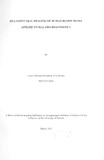| dc.description.abstract | Malaria is a serious disease whose confirmation in laboratories, usually by optical
microscopy, remains a challenge. The process involved in preparation of blood films and
their examination in the conventional microscopes is time consuming, and the results
may vary depending on the expertise of the examining technician, putting the lives of
patients at risk. Other laboratory techniques for confirming malarial infection are
expensive and may involve procedures that require extra training of personnel.
In this thesis, a method for rapid detection of Plasmodia (malaria parasites) in unstained
thin blood smears has been developed. The method is based on microscopically imaging
red blood cells using different wavelengths of light in the UV, visible and NIR region for
illumination (an emerging field known as multispectral imaging microscopy). Imaging
was accomplished by use of an optical microscope modified by replacing its tungsten
light source with a set of light emitting diodes (LEDs) whose emission spectra were
centered at 375 nm, 400 nm, 435 nm, 470 nm, 525 nm, 590 nm, 625 nm, 660 nm, 700
nm, 750 nm, 810 nm, 850 nm and 940 nm. These LEDs were made to illuminate the
samples from different orientations to obtain transmittance, reflectance, and dark-field
images to reveal different optical properties of the imaged sample. The microscope was
fitted with a monochrome CMOS camera that recorded the intensity of light emanating
from the specimen as gray-level images. Using in vitro cultures of red blood cells
infected with Plasmodium falciparum prepared as thin smears and without any stain,
congruent intensity images were recorded at different wavele
infected and non-infected red-blood cells.
Results obtained using Principal Components Analysis (PCA) and Hierarchical Cluster
Analysis (HCA) show that detection and identification of malaria parasites in
multispectral images is possible in the 375-940 nm range and relies on presence of
hemozoin (a pigment generated by the parasites when they digest haemoglobin).
Artificial Neural Network (ANN) model shows promising results in accurately
discriminating infected red blood cells from non-infected ones and in determining
parasite burden (parasitemia) in unstained human blood.
The developed method is rapid, with the whole diagnostic process taking approximately
10 minutes as opposed to the conventional microscopy which takes about 30 minutes. | en |

